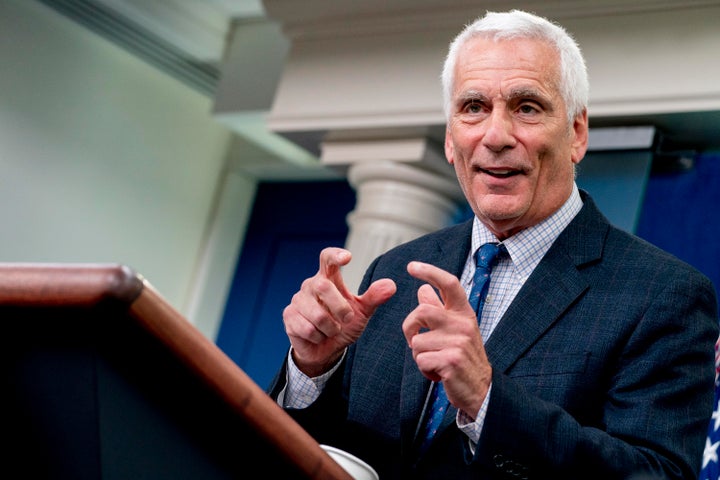The Jan. 6 insurrection at the U.S. Capitol played a significant role in the decision by one of the three major credit rating firms Tuesday to downgrade the nation’s pristine creditworthiness by a notch.
The 2021 attack, which also led to former President Donald Trump being indicted on multiple federal charges this week, was cited “repeatedly” by officials from Fitch Ratings, said a U.S. administration official who requested anonymity to speak to HuffPost.
And the man who made the downgrade call, Richard Francis, a co-head of Fitch’s Americas sovereign ratings division, said that the insurrection was something that loomed large in the agency’s considerations when deciding that the nation’s political dysfunction merited a credit demotion.
“We’ve seen a pretty steady deterioration in governance over the last couple of decades,” Francis said Wednesday on CNBC. “You can highlight a few key elements. One would be Jan. 6.”
Francis said Jan. 6 was not the only reason for downgrading Fitch’s assessment of U.S. governance, which was largely why overall creditworthiness was marked down.
“We’ve seen a pretty steady deterioration in governance over the last couple of decades. You can highlight a few key elements. One would be Jan. 6.”
– Richard Francis, co-head of Americas sovereign ratings for Fitch Ratings
He also cited “constant brinkmanship surrounding the debt ceiling, the debt ceiling debate,” as well as inaction on federal entitlement programs like Social Security and Medicare.
In its downgrade commentary, Fitch said, “The repeated debt-limit political standoffs and last-minute resolutions have eroded confidence in fiscal management.”
Financial markets mostly took the downgrade — which was released at nearly the same time as the Trump indictment was made public — in stride. Stocks were down a few hundred points Tuesday morning, and Treasury debt yields, which move opposite of their prices, were also up slightly.
Officials in Washington had largely assumed that a debt deal reached in early June — which came with more time to spare before the Treasury faced possible default, compared with some previous episodes — would take a downgrade off the table. But it may not matter much.
In 2011, the agency now known as S&P Global Ratings downgraded the U.S. for the first time ever in the wake of a standoff between then-President Barack Obama and a Republican-held House of Representatives. While the Government Accountability Office said that the impasse led to higher government borrowing costs of around $1.3 billion, the period studied did not include any impacts from S&P’s downgrade, which occurred a few days after the standoff ended.

Treasury and White House officials on Wednesday brushed off Fitch’s downgrade, which arrived as the Treasury preps for its high-profile quarterly debt sales next week. On Monday, it projected it would need to borrow about $1 trillion in the July-September quarter alone to keep the government afloat and restore the cash cushion that was drained by debt limit drama earlier in the year.
Josh Frost, the Treasury’s assistant secretary for financial markets, told reporters at a briefing Wednesday morning that there had been only “a very limited price response in markets” so far.
“We continue to see robust demand for Treasury securities, and the decision last night doesn’t change what Americans, investors and people all around the world already know, which is that Treasury securities remain the world’s preeminent safe and liquid asset, and that the American economy is fundamentally strong,” he said.
Indeed, President Joe Biden’s administration appeared less worried about any market impact from Fitch’s decision and more concerned about its timing.
The anonymous administration official said Fitch’s internal analytical model showed that the U.S. had pristine AAA credit under Obama, that it slipped to AA+ under Trump, and that Fitch failed to consider factors that should have merited AAA status now.
“The repeated debt-limit political standoffs and last-minute resolutions have eroded confidence in fiscal management.”
– Fitch Ratings
The official also said the June debt limit deal should have boosted Fitch’s assessment of U.S. governance, as the issue was resolved in time and on a bipartisan basis, and resulted in substantial deficit reduction.
Jared Bernstein, the chair of the White House Council of Economic Advisers, characterized Fitch’s decision to downgrade as “bizarre, arbitrary and against even their own estimates.”
“The idea that you would then somehow fail to do this under the prior administration, when these fiscal measures were massively deteriorating, and then go a notch down when we’re not only trying to move in the other direction but actually having some success in moving the other direction, it makes no sense,” he said in an interview with CNBC.
Francis, the division co-head at Fitch, said the rating could be changed upward if there was progress on the deficit and debt front, noting that the ratio of U.S. debt to gross domestic product was three times that of a typical country with the AAA rating.
“It’s much higher than the AAA median and much higher than any other AAA country actually, and it’s even higher than the AA category,” he said.

